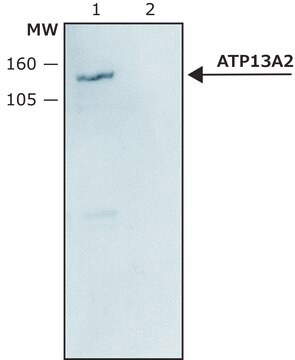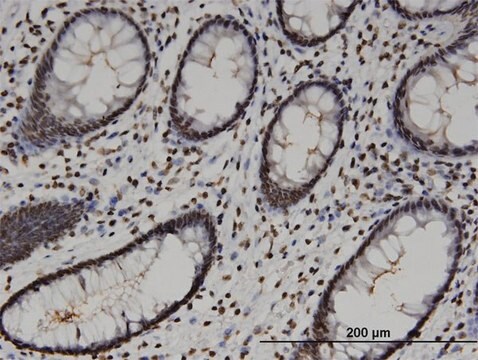推荐产品
生物源
rabbit
共軛
unconjugated
抗體表格
affinity isolated antibody
抗體產品種類
primary antibodies
無性繁殖
polyclonal
形狀
buffered aqueous solution
分子量
antigen ~129 kDa
物種活性
mouse, human
加強驗證
recombinant expression
Learn more about Antibody Enhanced Validation
濃度
~1.5 mg/mL
技術
western blot: 1.5-3.0 μg/mL using mouse brain extract (S1 fraction) or HEK-293T cells expressing human ATP13A2
UniProt登錄號
運輸包裝
dry ice
儲存溫度
−20°C
目標翻譯後修改
unmodified
基因資訊
human ... ATP13A2(23400)
一般說明
ATP13A2 (ATPase type 13A2, also known as PARK9) is a neuronal P-type ATPase of the P5 subfamily. It is present in the lysosome of transiently transfected cells, whereas the unstable truncated mutants are retained in the endoplasmic reticulum and degraded by the proteasome.
ATP13A2 is a member of the P5 subfamily of P-type transport ATPases which include ATP13A1-ATP13A5. Mutations in ATP3A2 also known as PARK9 are associated with hereditary Parkinson′s disease.
Rabbit anti-ATP13A2 (C-terminal region) antibody is specific for human and mouse ATP13A2. Staining of the ATP13A2 band by immunoblotting is specifically inhibited by the ATP13A2 immunizing peptide.
應用
Applications in which this antibody has been used successfully, and the associated peer-reviewed papers, are given below.
Western Blotting (1 paper)
Western Blotting (1 paper)
Rabbit anti-ATP13A2 (C-terminal region) antibody has been used for western blotting applications at a dilution of 1:1000.
生化/生理作用
ATP13A2 (ATPase type 13A2, also known as PARK9) shows elevated expression levels in the brains of sporadic Parkinson′s disease (PD) patients, suggesting a potential role in the more common forms of PD. It is associated with Kufor-Rakeb syndrome (KRS). KRS is a rare form of hereditary PD with juvenile onset. In addition to typical signs of PD, affected individuals show symptoms of more widespread pyramidal neurodegeneration, including dementia.
外觀
Solution in 0.01 M phosphate buffered saline, pH 7.4, containing 15 mM sodium azide.
免責聲明
Unless otherwise stated in our catalog or other company documentation accompanying the product(s), our products are intended for research use only and are not to be used for any other purpose, which includes but is not limited to, unauthorized commercial uses, in vitro diagnostic uses, ex vivo or in vivo therapeutic uses or any type of consumption or application to humans or animals.
Not finding the right product?
Try our 产品选型工具.
儲存類別代碼
12 - Non Combustible Liquids
水污染物質分類(WGK)
nwg
Alejandro Estrada-Cuzcano et al.
Brain : a journal of neurology, 140(2), 287-305 (2017-02-01)
Hereditary spastic paraplegias are heterogeneous neurodegenerative disorders characterized by progressive spasticity of the lower limbs due to degeneration of the corticospinal motor neurons. In a Bulgarian family with three siblings affected by complicated hereditary spastic paraplegia, we performed whole exome
Hereditary parkinsonism with dementia is caused by mutations in ATP13A2, encoding a lysosomal type 5 P-type ATPase
Ramirez A, et al.
Nature Genetics, 38(10), 1184-1184 (2006)
David Ramonet et al.
Human molecular genetics, 21(8), 1725-1743 (2011-12-22)
Mutations in the ATP13A2 gene (PARK9, OMIM 610513) cause autosomal recessive, juvenile-onset Kufor-Rakeb syndrome and early-onset parkinsonism. ATP13A2 is an uncharacterized protein belonging to the P(5)-type ATPase subfamily that is predicted to regulate the membrane transport of cations. The physiological
Mark Ainsley Colijn et al.
Neurogenetics (2024-07-18)
Biallelic (autosomal recessive) pathogenic variants in ATP13A2 cause a form of juvenile-onset parkinsonism, termed Kufor-Rakeb syndrome. In addition to motor symptoms, a variety of other neurological and psychiatric symptoms may occur in affected individuals, including supranuclear gaze palsy and cognitive
Aaron M Gusdon et al.
Neurobiology of disease, 45(3), 962-972 (2011-12-27)
Mitochondrial dysfunction and autophagy are centrally implicated in Parkinson's disease (PD). Mutations in ATP13A2, which encodes a lysosomal P-type ATPase of unknown function, cause a rare, autosomal recessive parkinsonian syndrome. Lysosomes are essential for autophagy, and autophagic clearance of dysfunctional
我们的科学家团队拥有各种研究领域经验,包括生命科学、材料科学、化学合成、色谱、分析及许多其他领域.
联系技术服务部门






